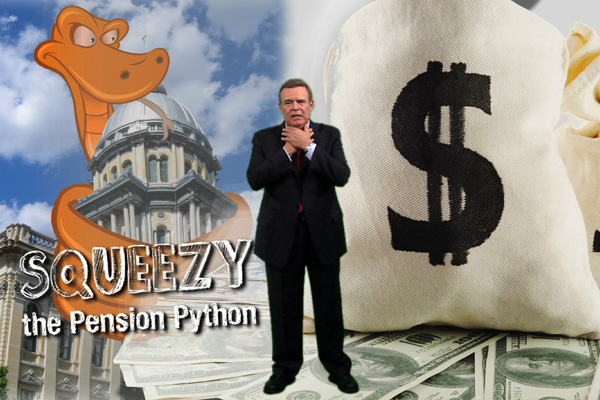
Photo: Office of the Governor
Governor Quinn came up with Squeezy the Pension Python to try to sell his ideas on pension reform.
The state just sold $1.3 billion worth of general obligation bonds yesterday. Obviously, the state is in debt. Obviously, its bond ratings have been downgraded. So, obviously, we're paying more for that debt at a time when money is relatively cheap:
Bonds due in 25 years in the Illinois deal yielded 5.65 percent or 160 basis points over Municipal Market Data's triple-A scale compared to a spread of 138 basis points on Tuesday. That matches the record-high 160 basis-point spread last hit in January 2011.
Or maybe it's not so obvious. Via Reuters's excellent muniland blogger Cate Long—who translates those numbers as "Illinois got spanked hard"—a new study by Marc Joffe, former senior director at Moody's, we might be paying too much given our actual default risk.
Whether you buy his argument or not, it's still an interesting read, and it gives a good bird's-eye view of Illinois budgeting. For instance:
Since 1981, Illinois’s appropriated-fund expenditures on education have increased at an annual rate of 4.52 percent. This is significantly lower than the rate of overall spending and revenue growth, and slightly below the rate of growth in personal income (4.82 percent). The growth of education spending has been relatively muted for two main reasons: (1) limited growth in the number of K–12 pupils and (2) periodic budget cuts to higher education. According to the Illinois State Board of Education (2004, 2012) statistics, K–12 enrollment increased from 1.956 million in the 1980–81 school year to 2.001 million in 2011–12. This 2.3 percent increase in enrollment contrasts with a 12.5 percent rise in state population—indicative of an aging population.
Figures reproduced in the State Budget Crisis Task Force’s report (2012) show significant cuts to higher-education spending from 2002 to 2004 and a flattening since 2008. In Illinois, as in other states, higher education has proved easier to cut than other budget items. State colleges and universities have responded to reduced government funding through a mixture of cost savings and tuition increases.
An aging population means that spending on health and social services has increased at 7.74 percent over the past 30 years, almost three precent more than personal income; growth in Medicaid spending increased 11.1 percent from 1990-2001, 6.6 percent from 2007-2010 (the author's estimates from federal sources).
So: aging population with increasing pension costs. We're doomed, right? Joffe doesn't think so.
In 2012, Illinois’s ratio of interest and pension expenses to revenues was 9.8 percent—well below the 30 percent threshold [of interest expenses to revenue] assumed to be the default point. Even under very bad economic conditions, it would take several years for Illinois to reach this default threshold. Consequently, in the near to intermediate term, Illinois’s modeled annual default probability would be zero under any plausible budget scenario.
With the assumptions used here, there is no breach of the 30 percent threshold [where default becomes likely] until 2030—when four trials in 1 million exceed this level. The frequency of default cases gradually increases until about 1.7 percent of the trials end in default by 2044. Even this default probability is likely to be an overstatement, because the projection does not assume policy adjustments after 2015.
This is both good and bad. A 1.7 percent chance of the worst-case scenario, even without policy changes, up from four in a million, suggests the difficulties the budget will face.
Joffe gets the 30-percent threshold from the Great Depression; since no state has defaulted since Arkansas in 1933 (Louisana and South Carolina technically defaulted around the same time), predicting the worst-case scenario is hard. Joffe's message to the market is that it needs to chill—the problem isn't insolvency, it's the effect of debt on state services.
And if they want the state to avoid default, chilling would help: "If this conclusion is embraced by investors, Illinois’s interest rates will be bid down, allowing the state to roll over its debt at lower coupon levels. The result would be reduced debt-service expenditures and thus a lower burden for taxpayers over the long term."
Unfortunately, that's a big if: All the state can do to lower the cost of debt is to reduce its debt, show it has the capacity to avoid debt, or hope the market buys Joffe's argument.



